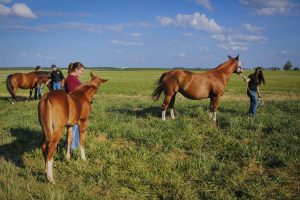Stories

Feb. 11, 2020
Office of Academic Programs presents at Staff Development Workshop
The Office of Academic Programs recently attended the 2020 Academic Programs Staff Development Workshop from Feb. 5-7, 2020, in Kissimmee, Florida. Five members of the team presented during the workshop. Those individuals and their presentations are listed below. Matt Arri, director of career services — Student Development Plan: An Online Guide to Academic Success and Career Readiness Shari Freyermuth, assistant dean and director of student services, and Laura Friedrich, senior student service coordinator — Keeping Students On Track to Graduation Shanon Dickerson, program director of study abroad — How to Pack Your Bags for Study Abroad: Recruiting, Marketing and Supporting…

Feb. 5, 2020
Eric Oseland Earns New Foundation for Soy Innovation Scholarship
Eric Oseland, PhD student in plant sciences, was selected as the first recipient of the Foundation for Soy Innovation’s new scholarship. Oseland will use the $1,000 award toward travel to the March 2020 Weed Science Society of America conference where he’ll present his research on dicamba and the effect it has on soybeans. Oseland works with Kevin Bradley, professor of plant sciences, on research observing the effect low soil pH has on dicamba volatility.

Feb. 4, 2020
Building a Network
As the director of career services in the CAFNR Office of Academic Programs, Matt Arri dedicates his time to building networks and relationships between CAFNR students and industry professionals. Arri’s goal is to make sure those students are career ready – and he has introduced a variety of new initiatives to help them along the way. It was an alum who helped set up the most recent Agribusiness Career Connections Program trip. Craig Bacon, senior vice president of technical services for Simmons Prepared Foods, was part of CAFNR’s Robert O. Reich Executive-in-Residence Program in October 2018. Bacon returned to campus…

Jan. 29, 2020
A Humble Giver
Sarah Lovell officially joined the University of Missouri College of Agriculture, Food and Natural Resources (CAFNR) in August 2019, as the H.E. Garrett Endowed Chair Professor and director of the Center for Agroforestry. Two months later, Lovell, who became just the second individual to hold the endowed chair position after Shibu Jose served eight years in the role, welcomed guests to the grand opening celebration of the Land of the Osages Research Center. Neither the H.E. Garrett Endowed Chair Professorship nor the Land of the Osages Research Center would have come to fruition if Gene Garrett would have ignored a…

Jan. 29, 2020
A Great Experience
J. Scott Angle never intended to have a career in agriculture. An interest in golf led Angle to turf management (agronomy) at the University of Maryland. The agronomy degree program was in the College of Agriculture and Natural Resources at the University of Maryland. “I had no interest in agriculture,” Angle said. “I grew up in the city, in Baltimore, and I didn’t really have any ties to agriculture. I did love golf and was focused on becoming a golf course superintendent. It just so happened that turf management was part of the agriculture college at the University of Maryland.”…

Jan. 10, 2020
Henry Nguyen Earns Distinguished International Honor
Henry Nguyen, Curators’ Distinguished Professor of Plant Genetics, was recently elected one of the 2020 fellows of the India National Academy of Agricultural Sciences. Fellows of the Academy are recognized for excellence in agricultural science, research, technology and innovation. Nguyen has made several significant contributions in drought tolerance research, especially in the root architecture in rice, as well as the stay green trait in sorghum. His research laid a foundation for genomic discovery and applications to rice and sorghum breeding for improved drought tolerance in India and worldwide.

Dec. 13, 2019
From CAFNR to Career
As a senior in high school, Cathy East had two in-state offers for scholarships to play soccer, one from the University of Missouri-St. Louis and one from Missouri University of Science and Technology in Rolla, Missouri. Growing up in St. Louis, East knew she wanted to go somewhere new for college, so she chose Missouri S&T, with the intent to transfer to the University of Missouri-Columbia as a junior to enroll in the School of Journalism. At the time, MU did not have a women’s soccer team. When she came to MU as a junior, East found it challenging to…

Nov. 27, 2019
‘The Pinnacle of My Career’
Growing up in Slovakia, a young Peter Sutovsky would often hold his own science-based lectures in front of his elementary classmates. Those lectures would generally focus on insects, as Sutovsky had a big interest in entomology. “I would bring in my insect collection and explain how the organs of a male beetle were different than the organs of a female beetle,” Sutovsky. “It was a bit precocious – and an early introduction to the birds and the bees. There was definitely a natural curiosity and interest in science from a young age.” Little did Sutovsky know then that his early…

Nov. 22, 2019
Growing CAFNR’s Research Footprint
It was 10 years ago when Shibu Jose joined the University of Missouri College of Agriculture, Food and Natural Resources (CAFNR) as the H.E. Garrett Endowed Chair Professor in the School of Natural Resources (SNR) and the director of The Center for Agroforestry. During the past year, Jose has served as the interim associate dean for research in CAFNR and director of the Agricultural Experiment Station (AES), CAFNR’s network of research centers throughout the state. The interim tag has now been officially removed. Jose’s appointment as associate dean for research and director of the AES is effective immediately. Jose became…

Nov. 14, 2019
Learning by Doing
Experiential learning is embedded throughout MU’s College of Agriculture, Food and Natural Resources courses. From Cafe at Eckles, a café operated by students and faculty of the hospitality management program, to Tiger Garden, a student-operated florist shop, there’s no shortage of opportunities for CAFNR students to gain valuable work experience. The Division of Animal Sciences recently added an Equine Science and Management Certificate, a program that will allow students to emphasize and quantify to employers their hands-on work experience with horses. “This certificate focuses on hands-on experience,” said Marci Crosby, an instructor within animal sciences and the coordinator of the…